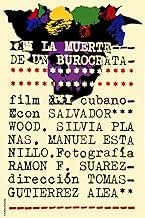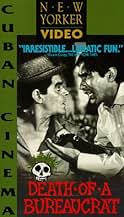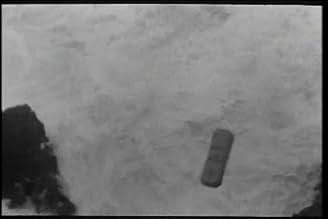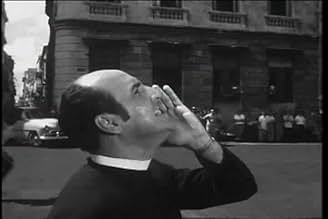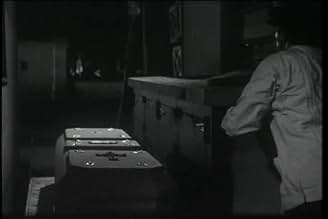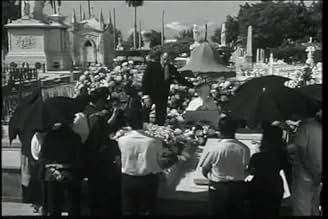ÉVALUATION IMDb
7,6/10
1,5 k
MA NOTE
Ajouter une intrigue dans votre langueA young man attempts to fight the system in an entertaining account of bureaucracy amok and the tyranny of red tape.A young man attempts to fight the system in an entertaining account of bureaucracy amok and the tyranny of red tape.A young man attempts to fight the system in an entertaining account of bureaucracy amok and the tyranny of red tape.
- Prix
- 1 victoire et 1 nomination au total
Histoire
Le saviez-vous
- AnecdotesThe girl who plays the girl n the black bikini with a hammer in the "Death to Bureaucracy" parade is Regina Amador, top model at Tropicana Club Havana, Cuba 1962-1968.
- Générique farfeluDedicated to Luis Buñuel, Stan Laurel and Oliver Hardy, Ingmar Bergman, Harold Lloyd, Akira Kurosawa, Orson Welles (as Orson Wells), Juan Carlos Tabio, Elia Kazan, Buster Keaton, Jean Vigo, Marilyn Monroe.
- Bandes originalesCoja el paso
Written by Frank Dominguez
Commentaire en vedette
Tomas Gutierrez Alea, Death of a Bureaucratic, Cuba, 1966
In a time of struggle between the United States and Cuba, when film was forbidden to leave Cuba, Tomas Gutierrez Alea managed to smuggle his Death of a Bureaucratic from his country. This great feat allowed Americans to view a Cuban's cinematography and also his satirical perspective of Cuban society under the reign of Castro. I believe that Alea did a wonderful job of showing how society and government worked during that time by using humor to depict a dark time. There was much symbolism present and foreshadowing. Since he was successful in turning otherwise disturbing situations into humorous ones, I think he could catch a broader audience and allow them to gain a small view of the situation in Cuba.
As the basis of the film, I believe that Alea was trying to show the government in the time of Castro rule. The Death of a Bureaucratic is a very fitting title to show this theme. Throughout the film there are scenes of artists' artwork advertising the smashing of bureaucracy. The overseer of the art was constantly critiquing his artists' works, telling them that the biceps needed to be much larger. Was this an attempt to portray that one must flex their muscles in order to appear, and not necessarily be, stronger and mightier? That Cuba or Castro was stronger and mightier than anyone else? Also, I believe that the major component of showing government in that time was how the nephew had to jump through so many hoops in order to obtain a simple document. First, he needed Paco's work card (for which he had been buried with). Then after unearthing Paco illegally, he had to get the same paperwork to bury him again. The humorous and frustrating parts were how many people and departments that the nephew had to see and go through in order to receive the approval to bury his uncle again. A funny part showing the regime of Castro was when one office worker was distributing a set amount of toilet paper to another. I thought it amusing and a good way to show how stringent and strict the government was.
There was a multitude of symbolism. I question the importance of beginning and ending the film with the sculpted angel in the cemetery. Paco was a sculptor and part of the story's theme was based on death – burying Paco, unearthing him, trying to rebury him and the demise of his nephew. Was the angel just a theatrical addition or possibly one showing the death of two souls? The sculptures also come into play that Paco was attempting to create a bust of Castro for every family in Cuba. In the end, that came to the demise of Paco and his nephew.
Death was highly prevalent in some obscure and obvious ways. I thought it funny that outside the first office the nephew enters, to get the needed approval, there is a man sitting with a scythe. Then the waiter has fangs at the restaurant where the nephew comes to an agreement with the cemetery crew to help him open his uncle's casket. Another amusing aspect that I noticed was that the mortician had a skeleton hanging in his rear-view mirror. The blackbirds that the nephew kept seeing, I believe, foreshadowed his impending demise and kept with a theme of death.
As far as the cinematography, there were many elements I thought interesting. The one that stood out most to me was when Paco's machine malfunctioned and he was attempting to fix it. That scene differed from the rest of the movie. It was cartoon-like. The accelerated motion added to this element. That scene reminded me of movies during Charlie Chaplin's time when there was no sound and the actors were over-dramatic in order to express the emotion and events in the film. I thought the transitions between scenes were defined and effective. It seemed to me that they were close to what we see in movies today. Alea's choice of score blended in to where I didn't feel that it overpowered the shot or effectiveness of the acting and film but was rather mostly an enhancement.
A review from IMDb.com references the dream sequences used by Alea. They make reference that these are similar to those of Bunnel. Said dream sequences baffled me. There was an homage made to Alea's friend, Dali, when the nephew, Juanchin, was pulling the coffin. This was a sign of carrying a heavy weight or baggage. Although the dreams were a prominent part in the film, I found them confusing and creepy.
All in all, I believe that Alea's Death of a Bureaucratic was a humorous portrayal of the darker time under Castro's rule.
In a time of struggle between the United States and Cuba, when film was forbidden to leave Cuba, Tomas Gutierrez Alea managed to smuggle his Death of a Bureaucratic from his country. This great feat allowed Americans to view a Cuban's cinematography and also his satirical perspective of Cuban society under the reign of Castro. I believe that Alea did a wonderful job of showing how society and government worked during that time by using humor to depict a dark time. There was much symbolism present and foreshadowing. Since he was successful in turning otherwise disturbing situations into humorous ones, I think he could catch a broader audience and allow them to gain a small view of the situation in Cuba.
As the basis of the film, I believe that Alea was trying to show the government in the time of Castro rule. The Death of a Bureaucratic is a very fitting title to show this theme. Throughout the film there are scenes of artists' artwork advertising the smashing of bureaucracy. The overseer of the art was constantly critiquing his artists' works, telling them that the biceps needed to be much larger. Was this an attempt to portray that one must flex their muscles in order to appear, and not necessarily be, stronger and mightier? That Cuba or Castro was stronger and mightier than anyone else? Also, I believe that the major component of showing government in that time was how the nephew had to jump through so many hoops in order to obtain a simple document. First, he needed Paco's work card (for which he had been buried with). Then after unearthing Paco illegally, he had to get the same paperwork to bury him again. The humorous and frustrating parts were how many people and departments that the nephew had to see and go through in order to receive the approval to bury his uncle again. A funny part showing the regime of Castro was when one office worker was distributing a set amount of toilet paper to another. I thought it amusing and a good way to show how stringent and strict the government was.
There was a multitude of symbolism. I question the importance of beginning and ending the film with the sculpted angel in the cemetery. Paco was a sculptor and part of the story's theme was based on death – burying Paco, unearthing him, trying to rebury him and the demise of his nephew. Was the angel just a theatrical addition or possibly one showing the death of two souls? The sculptures also come into play that Paco was attempting to create a bust of Castro for every family in Cuba. In the end, that came to the demise of Paco and his nephew.
Death was highly prevalent in some obscure and obvious ways. I thought it funny that outside the first office the nephew enters, to get the needed approval, there is a man sitting with a scythe. Then the waiter has fangs at the restaurant where the nephew comes to an agreement with the cemetery crew to help him open his uncle's casket. Another amusing aspect that I noticed was that the mortician had a skeleton hanging in his rear-view mirror. The blackbirds that the nephew kept seeing, I believe, foreshadowed his impending demise and kept with a theme of death.
As far as the cinematography, there were many elements I thought interesting. The one that stood out most to me was when Paco's machine malfunctioned and he was attempting to fix it. That scene differed from the rest of the movie. It was cartoon-like. The accelerated motion added to this element. That scene reminded me of movies during Charlie Chaplin's time when there was no sound and the actors were over-dramatic in order to express the emotion and events in the film. I thought the transitions between scenes were defined and effective. It seemed to me that they were close to what we see in movies today. Alea's choice of score blended in to where I didn't feel that it overpowered the shot or effectiveness of the acting and film but was rather mostly an enhancement.
A review from IMDb.com references the dream sequences used by Alea. They make reference that these are similar to those of Bunnel. Said dream sequences baffled me. There was an homage made to Alea's friend, Dali, when the nephew, Juanchin, was pulling the coffin. This was a sign of carrying a heavy weight or baggage. Although the dreams were a prominent part in the film, I found them confusing and creepy.
All in all, I believe that Alea's Death of a Bureaucratic was a humorous portrayal of the darker time under Castro's rule.
- lashleym
- 19 mars 2012
- Lien permanent
Meilleurs choix
Connectez-vous pour évaluer et surveiller les recommandations personnalisées
- How long is Death of a Bureaucrat?Propulsé par Alexa
Détails
- Date de sortie
- Pays d’origine
- Langue
- Aussi connu sous le nom de
- Death of a Bureaucrat
- Lieux de tournage
- La Habana, Cuba(town of the action)
- société de production
- Consultez plus de crédits d'entreprise sur IMDbPro
Box-office
- Brut – à l'échelle mondiale
- 3 323 $ US
- Durée1 heure 25 minutes
- Couleur
- Mixage
- Rapport de forme
- 1.66 : 1
Contribuer à cette page
Suggérer une modification ou ajouter du contenu manquant

Lacune principale
By what name was La muerte de un burócrata (1966) officially released in Canada in English?
Répondre
